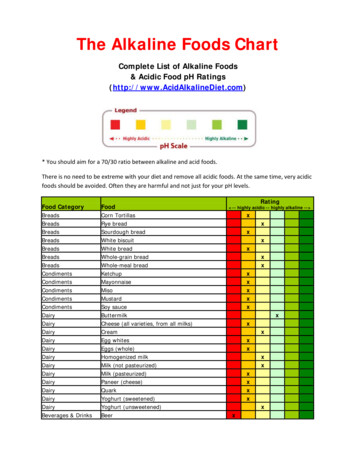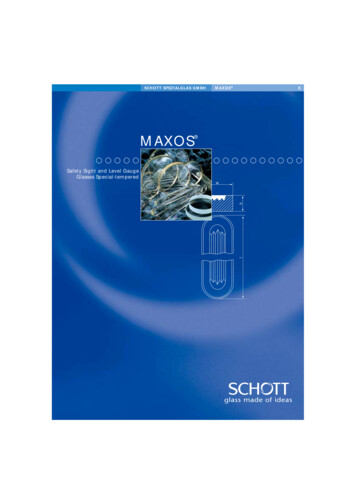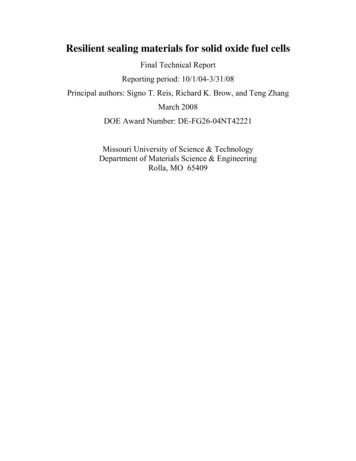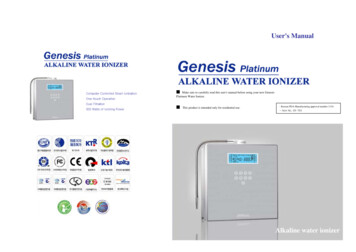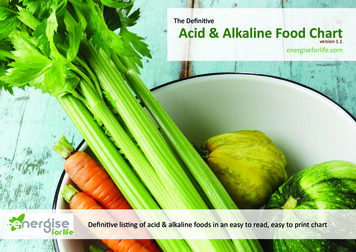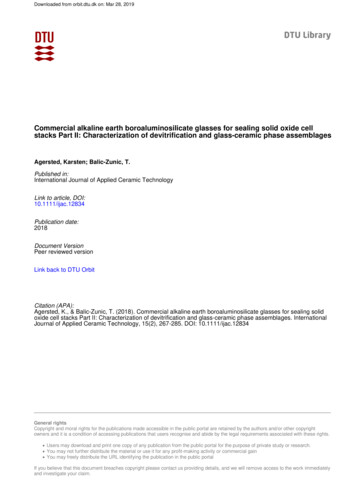
Transcription
Downloaded from orbit.dtu.dk on: Mar 28, 2019Commercial alkaline earth boroaluminosilicate glasses for sealing solid oxide cellstacks Part II: Characterization of devitrification and glass-ceramic phase assemblagesAgersted, Karsten; Balic-Zunic, T.Published in:International Journal of Applied Ceramic TechnologyLink to article, DOI:10.1111/ijac.12834Publication date:2018Document VersionPeer reviewed versionLink back to DTU OrbitCitation (APA):Agersted, K., & Balic-Zunic, T. (2018). Commercial alkaline earth boroaluminosilicate glasses for sealing solidoxide cell stacks Part II: Characterization of devitrification and glass-ceramic phase assemblages. InternationalJournal of Applied Ceramic Technology, 15(2), 267-285. DOI: 10.1111/ijac.12834General rightsCopyright and moral rights for the publications made accessible in the public portal are retained by the authors and/or other copyrightowners and it is a condition of accessing publications that users recognise and abide by the legal requirements associated with these rights. Users may download and print one copy of any publication from the public portal for the purpose of private study or research. You may not further distribute the material or use it for any profit-making activity or commercial gain You may freely distribute the URL identifying the publication in the public portalIf you believe that this document breaches copyright please contact us providing details, and we will remove access to the work immediatelyand investigate your claim.
Accepted ArticleDR KARSTEN AGERSTED (Orcid ID : 0000-0002-5270-7441)Article type: Special Issue ArticleCommercial alkaline earth boroaluminosilicate glasses for sealing solid oxide cell stacksPart II: Characterization of devitrification and glass-ceramic phase assemblagesKarsten AGERSTED, Technical University of Denmark, Dept. of Energy conversion and storage,Denmark (kagn@dtu.dk corresponding author)T. Balic-Zunic, Copenhagen University, Museum for natural history, DenmarkAbstractThe devitrification process and formation of crystalline phases from commercial alkaline earthboroaluminosilicate glasses containing 48-61 mol% SiO2, 18-28 mol% CaO, 1-7 mol% MgO, 7-10mol% Al2O3, 1-11 mol% B2O3 plus minor amounts of Na2O, K2O, FeO and TiO2 were quantifiedthrough analysis of phase assemblages as function of heat treatments above the glass transitiontemperatures using the electron microprobe and powder X-ray diffraction. Treatments at 800 Cand 850 C lasted up to 6 weeks.Results indicate that devitrification was strongly activated through presence of heterogeneousnucleation, and that the growth mechanism gradually changed from three-dimensional growth atthe onset of devitrification towards one-dimensional growth in later stages, when heterogeneousnucleation was absent or less dominating.This article has been accepted for publication and undergone full peer review but has notbeen through the copyediting, typesetting, pagination and proofreading process, which maylead to differences between this version and the Version of Record. Please cite this article asdoi: 10.1111/ijac.12832This article is protected by copyright. All rights reserved.
Most glasses developed entangled and fibrous microstructures with little or no residual glassAccepted Articlephase, which are adequate for rigid sealants, and only one of the laboratory analogue glasses,MCAS, developed microstructures with both more equiaxed grains and a considerable amount ofresidual glass phase, which may be adequate for more compliant and self-healing sealants asoften required in SOC-applications.Even though the glasses lie within a relatively narrow compositional range, resulting phaseassemblages differed significantly. Anorthite (plagioclase) developed as the main crystallinephase in all samples together with pyroxene (or pyroxenoide) and cristobalite. Calciummagnesium-silicate pyroxene (diopside) was in a large part replaced by the calcium-silicatepyroxenoid (wollastonite) in the samples where the mol-proportion MgO:CaO was 1:5 or lower.In samples with a very low MgO proportion and consequently a high CaO proportion, calciummetaborate and calcium aluminum borosilicate (okayamalite) crystallized among the main phasesand these glasses crystallized completely within the period of heat treatment. Althoughcristobalite is metastable at the annealing temperatures, both α and β forms were rapidly formedin most of the samples, likely due to kinetic reasons. The presence of the latter is explained bythe stabilization effect of Al and B substitution for Si compensated by Ca stuffing in the structure.The stuffed cristobalite transformed with time to quartz (at 800 C) or quartz plus tridymite (at850 C). Boron was incorporated in the first crystallizing phases, especially diopside, substitutingfor Al and Si, but the so established substitution partly disappeared with time during the heattreatment.This article is protected by copyright. All rights reserved.
Accepted ArticleIntroductionGlass ceramic sealants for solid oxide cell (SOC) stacks are primarily characterized for their sealingand thermomechanical behavior, in specific settings or environments in terms of neighborcomponents and sealing profile, being the most relevant factors if a limited number of sealantsare to be evaluated. If more candidates are at hand, a different approach may be taken, as in thiswork, where a comparison of sealing properties and development of phase assemblages in a setof commercially available alkaline earth boroaluminosilicate glasses was conducted to becomeindependent of influence from any neighbor components and make results generally applicable.These glasses are better known for their durability and low thermal expansion, but have shown toattain sufficiently good sealing properties in the temperature range of interest for solid oxide cell(SOC) sealants as well as satisfactory performance through repeated thermal cycling1,2. Glassesare containing 48-61 mol% SiO2, 18-28 mol% CaO, 1-7 mol% MgO, 7-10 mol% Al2O3, 1-11 mol%B2O3 plus minor amounts of Na2O, K2O, FeO and TiO2 and may be seen as an alternative to moreexpensive commercial glasses in which thermomechanical match towards sealing counterpartsand medium to high coefficients of thermal expansion (CTE), e.g. in the range 10-13 10-6 K-1 asexperienced in SOC stacks, have been tailored through higher contents of alkaline or alkalineearth metals, e.g. barium or strontium, or other metal ions with relatively high ionic radii.Prior to the present work it has been observed that smaller variations in the composition of thecommercial glasses sold under the same label as well as variations in the processing of theglasses, e.g. milling, introduced marked differences in the sealing behavior as well as thethermomechanical properties of the glass ceramics. To investigate how different processingroutes; hyper-quenching, as used in mass production of fibrous glasses and quenching, astypically used in production of smaller batches, laboratory analogues of the commercial glasseswere also included in the study. Hence, the scope of the work was to characterize how thedevitrification processes and the phase assemblages developed due to influences from variationsThis article is protected by copyright. All rights reserved.
in nucleation mechanism and overall composition. Particular interest has been on possibleAccepted Articleinfluences from the boron content in the glasses, and establishing reliable procedures forquantification of the boron-contents in the various phases of the assemblies have beenprioritized.Crystallization from a glass has routinely and successfully been characterized by DTA/DSCtechniques following the findings of Matusita et al. 3,4 although their procedure was developed todescribe simpler systems than often cited in literature and assumes that the thermal responsecan be ascribed to one dominant devitrification process. Despite fundamental shortcomings incomplex systems like the alkaline earth boroaluminosilicate the method has been used toillustrate differences in the crystallization behavior between non-milled fiber materials and milledmaterials. Viscosities of the glasses were not measured in particular, e.g. by hot stagemicroscopy5, but modelled according to a generalized procedure developed for industrial glasses6based on the statistical behavior of the individual components of the glasses. The model predictsviscosity with an error of 12 ºC within the compositional limits specified and producesparameters (A, B, To) for calculation of viscosities according to the Vogel-Fulcher-Tammann (VFT)equation7 above Tg for the glasses:log(η) A B/(T-T0) (Pa*s)(1)ExperimentalThe glasses f11 and f30 listed in Table 1 designate commercially available glass fiber materials (f),which experienced hyper-quenching during fiber spinning. They have been cut into shorter fibersand heated to 500 C in air for 2 hours to remove organic species. Crushed fiber versions, withThis article is protected by copyright. All rights reserved.
the prefix “cf”, were produced from grinding such fibers in a ball mill and subsequently in aAccepted Articleplanetary mill equipped with zirconia milling media. MCAS and c30b were both made fromanalytical grade Me-oxides and carbonates mixed in a ball mill, heated at 2 C/min and held at1400 C for 4 hours before cooling to room temperature at 2 C/min. Subsequently, a secondbatch of raw materials was added to the crucible and the melting procedure was repeated twomore times, hence processing one third of the raw materials each time. The glass was thenheated again to 750 C, quenched in water and thereafter ground to powder. Glass P, acommercial low-Boron glass hyper-quenched as pearls, was sieved and only pearls passing a 45μm mesh were used for the experiments.The ground glass materials (MCAS, cf11, cf30 and c30b) having average grain sizes below 10 µmand the glass pearls (glass P) were uniaxially pressed at 40 MPa into rectangular pellets of welldefined length (50mm), height (5 mm) and width (7-10 mm), which weighted between 3.3 g and5 g. An organic binder solution was added in small amounts to facilitate handling of the pellets.To obtain coherency of samples from glass P, this material was subjected to a pressure less than20 MPa equivalent to the minimum reading of the press. Unsuccessful attempts were made topress the fibers of f11 into pellets and instead fibers were stacked and annealed in the asreceived shape: 6 mm long fibers with a diameter of 6.5 μm. All samples rested on gold foilduring the annealing.The samples were heated with a heating rate of 100 C/h and held at the annealing temperaturefor 4 h, 24 h, 168 h, 336 h or 1008 h respectively, and hereafter quickly removed from the furnaceand cooled by exposure to room temperature. Reference samples of each glass were removedfrom the furnace shortly after reaching the desired temperature, and these samples have beenassigned an arbitrary value of 1h in the following, to mark the starting point. Both thetemperature uniformity inside the furnace and the long-term drift varied in the order of a fewThis article is protected by copyright. All rights reserved.
degrees, which is regarded as negligible for the desired temperature accuracy. The furnace wasAccepted Articleopened several times for removal of samples, but the short-term drop in temperature of about50oC experienced by samples kept in the furnace for longer times is considered not to influencethe results.Analytical methodsPellets were cut, mounted in epoxy, polished and carbon-coated for evaluation of microstructureand chemical composition in an electron microprobe (WDS in JEOL Superprobe JXA-8200) ataccelerating voltage of 8 kV (10 kV when measuring Fe, Ti and B) and a current of 6 nA. Workingdistance (WD) was 11 mm and count intervals generally of 10 s on the peak and 5 s on thebackground on each side of the peak (20 s and 10 s, respectively, for boron) with a spot size of 2μm. Table 1 lists the standards used for each element. The first attempts using danburite as theboron standard resulted in a poor match to the values of boron contents determined by wetchemical analysis of glasses. A reason may be that the coordination environment of boron indanburite significantly differs from the boron coordination in the glass8. Therefore a sample ofthe MCAS glass was chosen as a standard for boron, with the quantity of B2O3 obtained from thewet-chemical analysis. Parts of the heat treated samples were crushed to a fine powder in anagate mortar for XRD measurements with Cu Kα-radiation in a Bruker-AXS D8 diffractometerequipped with a primary Ge(111) mono-chromator and a LynxEye fast Si-strip position sensitivedetector covering 3.3o. Measurements were performed in reflection mode within a 2θ range of 5 to 90 , with step size of 0.02 and 4s step time.DSC analysis in a Netzsch DSC 404 C were done by heating of the powdered glass samples (d50 10 µm) in argon at four different heating rates; 1, 5, 10, 40 C/min until 1300 C. The range ofheating rates include the relative low heating rates, 1-2 C/min, used in SOC stack sealing andinitialization. Baselines were established for each heating rate and subtracted from raw data.Sample size was held constant at 25-30 mg.This article is protected by copyright. All rights reserved.
For XRD at elevated temperatures a MRI BASIC high temperature stage (max. temp. 1500 C,Accepted Articlesample holder Pt20%Rh) was used at a 2θ range from 50 to 1000, step size of 0.00990 , step timeof 1 s and a divergence slit with v 6.00. Powders were suspended in ethanol, applied onto thesample holder and dried prior to analysis.Preliminary phase identification was performed in EVA software package (Bruker AXS product).Quantitative phase analysis (QPA) using the Rietveld method9,10 was done through the softwareTOPAS vers. 4.1 from Bruker AXS. Crystal lattice parameters for the detected phases and sourcesfor the crystal structure data are listed in Table 2. During Rietveld refinement only the crystallattice parameters, scale factors and crystallite sizes were varied for crystalline phases, atomicparameters were kept constant. Fundamental profile method was used and a CeO2 sample of aknown average crystallite size (590 nm) used as external standard. Due to the large number ofsamples, the amount of the residual glass (amorphous component) was not determined by therelatively accurate addition method, but by a simpler one which did not require the additionalsample preparation and doubling of the analyses. It was recognized that the amorphous signal ofthe borosilicate glass can be modelled by a pseudo-quartz structural model, which releases thelattice parameters and crystallite size in crystalline data of quartz and adjusting the atomic siteoccupancies to achieve the appropriate glass densities, cf. Figure 1. The “crystal latticeparameters” thereby obtained deviated from the real quartz values and the nominal crystallitesize, which determines the width of the diffraction maxima, was of an extremely low value (0.80.9 nm). The diffraction characteristics of each glass were obtained by this procedure on the startsamples heat-treated for one hour. They proved to be either pure or over 90 % glasses. Themodelled structural parameters for glasses were subsequently used for quantitative estimationsduring Rietveld refinement of other samples, only adjusting the scale factor for the glass function.To check the accuracy of the method, the samples of glasses cf11 and c30b treated for fourweeks at 800o C were also investigated by the combination of Rietveld refinement and theaddition method11 for which exact equations exist and where the amorphous signal is modelledThis article is protected by copyright. All rights reserved.
as a part of the background. The additive, quartz, was chosen in order not to change the X-rayAccepted Articleabsorption in the sample significantly. The amounts of glass determined by the combination ofRietveld refinement and the addition method were 18.4 wt% and 0 wt% to be compared to theamounts of glass obtained by the presently applied method, which were 19.3 wt% and no glass,respectively. The results in other samples reported here were additionally checked byrecalculating the results of the Rietveld refinements in summary wt% of oxides and comparingwith the known starting composition of the glasses. The specific response of the vitreous phase inthe applied method may change with glass composition, e.g. boron enrichment, as well as withphase separation, but the relatively good correlation between results with and without standardaddition has led to an acceptance of the applicability of the method. Mass balances showed nonsystematic overestimations of silica and underestimation of B2O3, but as these were mainly foundin glasses with phase separation (MCAS, f11, cf11) it has been ascribed more to the uncertaintyof the average composition of the glass phases measured by EMPA. Randomly distributeddiscrepancies in wt% of other oxides amounted to few percent, relatively, which is at a similarlevel as the accuracy of the glass content estimations that lies within few wt%,ResultsFigure 2 depicts the result from modelling6 the glass viscosity and it is seen that pristine glassesdo not differ very much, except for the laboratory-analogue, c30b, which may be expected toappear more viscous than its commercial model, cf30, and maybe even show faster nucleationand crystallization properties. The modeling also illustrates a marked increase of the fragility ofthe vitreous phase as function of the compositional changes induced by crystallization on aging.This article is protected by copyright. All rights reserved.
Figures 3-5 show a set of results; the development of phase assemblages with time at fixedAccepted Articletemperatures, concentration of oxides (EMPA) in the residual glass phases and selected examplesof the microstructures for the glass f11. Subsequent figures 6-15 follow this template and coversimilar results for the lot of glass ceramics and annealing conditions used in the present study.The volume fraction of the phase assemblages have been shown in log-log scaling, and in thecases where linear trend lines could be drawn, the slope of these trends have been listed in Table3 to illustrate the difference between crystallization processes that are hindered, slope 1, andprocesses that are not, slope 1. Slopes significantly higher than unity likely indicate conditions ofeutectic crystallization or supersaturation. The EMPA-analysis on residual glass phases showedthat in general, concentrations of magnesium, aluminum, silicon, and sodium dropped after theonset of crystallization, whereas concentrations of calcium and boron rose cf. Figures 4, 7, 10, 13,which also complies well with another general observation that crystallization of nominallyboron-free phases were kinetically favored and that the glass transition temperatures of theresidual glass phases, Tg, generally decreased on aging.Selected results from characterization of the devitrification processes3,4 have been listed in Table4. The Avrami parameter, n, has been calculated as the linear slopes from so-called Ozawa-plots3of ln[-ln(1-x)] versus ln(α), in which “x” denotes the degree of reaction (crystallization) at selectedtemperatures (T) evaluated from the areas of the DSC-peak obtained at various heating rates “α”.G(T) denotes a crystallization function, dependent on the mechanism and constant at constanttemperature:ln[-ln{1-x(T)}] G(T) -n ln(α)(2)The Avrami parameter assumes values close to unity (1) for the glasses MCAS, cf30 and c30b,which corresponds well to expectations of surface nucleation dominating the devitrificationprocesses. In contrast, the Avrami parameter for the milled fibers, cf11, is far from being constantThis article is protected by copyright. All rights reserved.
and seems to drop from higher numbers at lower temperatures towards unity as temperatureAccepted Articleincreases and thereby following the trends of the Avrami parameters for the non-milled andquenched samples, f30, f11, Glass P.The influence from temperature on the devitrification process can be seen from Figures 3 and 6where the temperature increase of 50 ºC reduced the time for onset of the devitrification fromapproximately 100 h to about 6 h for f11 and from about 10h to 1h for cf11. The developmentof phase assemblages seemed in both cases to be relatively unaffected by the temperaturedifference and the distribution of elements among the main phases after 1000h ageing wasrelatively consistent. The figures also illustrates that introducing sites for heterogeneousnucleation by crushing the fibers reduced the time for onset of devitrification by approximatelyan order of magnitude as well as promoted the transition from cristobalite into quartz. A possibleeffect of homogeneous nucleation may be observed in comparing the phase assemblages in cf30and c30b, cf. Figure 9, where the different crystalline borate phases may reflect differentnucleation patterns. A similar comparison between MCAS and cf11 points towards a faster onsetof devitrification of the slowly cooled sample, and to differences in the microstructure of theglass ceramics that appears more homogeneous for the quenched and milled sample. A similartrend is also observed between samples of c30b and cf30.Anorthite (plagioclase) crystallized among the first appearing phases in all glasses and is also themain phase in all samples having a composition, except in glass P, very close anorthite with only5-10 mol% Na. Glass P contained more than twice the alkali content to calcium compared to theother glasses and the plagioclase, which formed therein had a larger unit cell, 1345 Å3 comparedto 1330-1335 Å3 in the others, so it is expected that anorthite in glass P incorporated more Nathan in other samples. Rietveld refinement was tried with various structural data from theplagioclase family. The best R factor was obtained with the data of andesine with 37 mol%anorthite12 and the plagioclase in glass P is probably more albitic than anorthitic. For anorthite inThis article is protected by copyright. All rights reserved.
other samples, the crystal structure data of plagioclases13 with 96 mol% anorthite (cf30, f11) andAccepted Article89 mol% anorthite (MCAS, cf11, c30b) were used in Rietveld refinements. XRD observationsshowed a slow growth of the anorthite (plagioclase) unit cell volume during annealing. Thecrystallite size of anorthite, except in glass P, grew from the starting average size (XRD) of 100 nmto about 200 nm in six weeks. The average crystallite size of plagioclase in glass P was significantlylower and remained around 50 nm even after the six weeks.In both f11 and to some extent also in the cf11, initial plagioclases showed a high silica-contentand cation to oxygen ratios around 4.7 to 8, cf. Table 5. The composition was relatively consistentin all samples, but was outside the range of both supersilicic anorthite with vacancies in Ca sites(up to 11% vacancies14) and stuffed cristobalite (below 10% substitution/stuffing15) and fallingapproximately half-ways between them. Additionally to a general boron and magnesiumdepletion on aging, plagioclase was observed by both XRD and EMPA to partly re-crystallize, andthe starting non-stoichiometric compositions were gradually replaced by stoichiometric phases,cf. Table 5. This was not seen similarly in the more calcium-rich cf30 and c30b glasses. In MCASglass, that has almost the same (Mg, Ca)-proportion as f11 and cf11, the anorthite-cristobalite“solid solution” was also transient and seemed to be coexisting with pure and boron-freeanorthite.Diopside is the second most abundant phase, except in cf30, c30b and in glass P where it waspartly replaced by wollastonite. Diopside also crystallized among the first appearing phases andshowed compositional changes with time, cf. Table 6. In all samples, the diopside, whichcrystallized first, had a larger Al and B substitution for Si (EMPA), and the proportions of Al andespecially B decreased with annealing. Diopside was also a sink for amounts of Fe and Ti presentin glasses, which together with Al partly substituted Mg in all samples (EMPA)16. The changes ofthe crystal lattice parameters were small, showing a general increase of the unit cell dimensionswith time. This was due to the expansion of the a- and b-lattice periods, whereas the c-periodcontracted slightly, which is in accordance with contraction of pyroxene chains, which run in thisThis article is protected by copyright. All rights reserved.
direction, caused by diminishing amounts of Al and B substituting for Si. The crystallite sizes ofAccepted Articlediopside were typically larger than those of anorthite/plagioclase showing average sizes around200-300 nm. The crystal structure data used in Rietveld refinement of diopside were those forthe aluminian diopside17 but with the atomic site occupancies derived for each case from thecorresponding EMPA results. The Si- and Mg-substitutions diminished with time, cf. Table 6, butdiopside still kept substitution of trivalent cations in both T and M1 sites at 1008h and can beclassified as aluminous diopside.Wollastonite appeared prior to diopside in samples c30b and cf30, which had lower magnesiumto calcium ratios than MCAS and f11, and simultaneously with diopside in glass-P, which hadsignificantly lower alumina and borate and higher silica concentrations. Wollastonite showedmuch smaller, if any, substitution of Al and B for Si and was always very close to stoichiometricCaSiO3 (EMPA). Like anorthite and diopside, wollastonite showed a growth of the unit cell volumewith annealing (XRD). The average crystallite size of wollastonite matched that of diopside exceptin glass P, where it was significantly smaller and also showed a smaller unit cell volume thanwollastonite in cf30, cf. Table 2. The crystal structure data for wollastonite used in Rietveldrefinement were those of the most common 1A polytype18. Wollastonite in the shape of smalldendritic crystals of an average size below 100 nm made about 1/3 of the volume in glass P,whereas diopside formed mostly as isolated crystals of larger sizes around 1 μm. It is alsointeresting to note that even though wollastonite was readily formed in c30b, it seemed to beresorbed on further aging, which was not happening as apparent in cf30.Cristobalite was present in all samples and represented the first crystallizing form of silica, whichtypically appeared a little later than anorthite and diopside/wollastonite on annealing, except inglass P where it was present at 2 vol% from the very beginning. In all samples, except in glass P,XRD indicated the presence of two types of cristobalite with different crystal lattice periods,which could be evaluated from the main diffraction maximum corresponding to around 4.05 Ålattice plane spacing. A significant improvement in the reliability index (R) of several % wasThis article is protected by copyright. All rights reserved.
achieved during Rietveld refinement if two cristobalites rather than one were introduced withAccepted Articledifferent crystal lattice parameters, which is then assumed to represent the high- and the lowtemperature form of this structure with larger (d011 4.08 Å) and smaller (d011 4.04 Å) crystallattice parameters, respectively, belonging to different tetragonal space groups19. It was,however, not possible to confirm the presence of the two different symmetries from the XRDresults, because they are discriminated through the absence or presence of minor diffractionmaxima which were heavily overlapping with the other phases in the samples. It is likely that thehigh-temperature form was stabilized by partial substitution of Si by Al (and possibly B) and“stuffing” the structure with some Ca, as found in synthesis works15, but it was not possible toapprove it by EMPA due to very small sizes of the cristobalite grains. The average crystallite sizeof cristobalite was typically below 100 nm (XRD) and it often appeared in intimate mixtures withanorthite (EMPA) where it looked like residual silica formed during the crystallization ofanorthite. According to XRD, only the low-temperature form of cristobalite formed in glass P andit crystallized even faster, cf. Figure 3 and Figure 12. Both quartz and tridymite were absent fromglass P.Quartz developed as the stable silica form from cristobalite during the prolonged annealing ofsamples. The samples annealed at 850 C were close to the transition temperature quartztridymite and also the latter silica form was found therein20. In all samples, quartz21 showedslightly increased crystal lattice parameters as was confirmed both by the results of Rietveldrefinement which was self-correcting and by the measurement of one sample with the additionof quartz standard and may reflect the presence of impurities in composition and/or a strainedcrystal structure.Transition from cristobalite to quartz seemed in most cases to go through a 1st-order processfollowing the slope 1 in the log-log-plot and was more pronounced in cf11 and cf30 than in f11and c30b respectively. The concentration of quartz was even reduced in c30b after 168h.Okayamalite, which is the boron analogue of gehlenite with the same basic crystal structure,This article is protected by copyright. All rights reserved.
appeared in the Mg-poor Ca-rich borosilicate samples c30b and cf30. It formed in c30b one of theAccepted Articlemain constituents, taking around ¼ of the volume and it started to crystallize when the amountof remnant glass was also dramatically reduced, cf. Figure 9. Chemical analysis revealed acomposition close to Ca2Al0.4B1.6SiO7, hence identified it as a member of the solid solution seriesbetween okayamalite and gehlenite with the former component dominating (80 mol%). The
These glasses are better known for their durability and low thermal expansion, but have shown to attain sufficiently good sealing properties in the temperature range of interest for solid oxide cell (SOC) sealants as well as satisfactory performance through repeated thermal cycling1,2. Glasses are containing 48-61 mol% SiO 2
